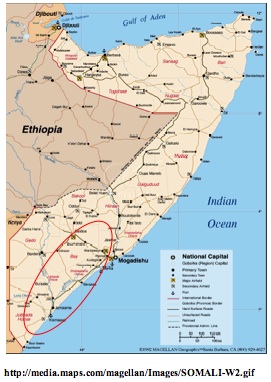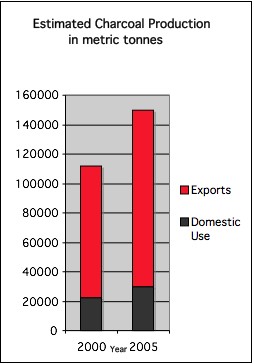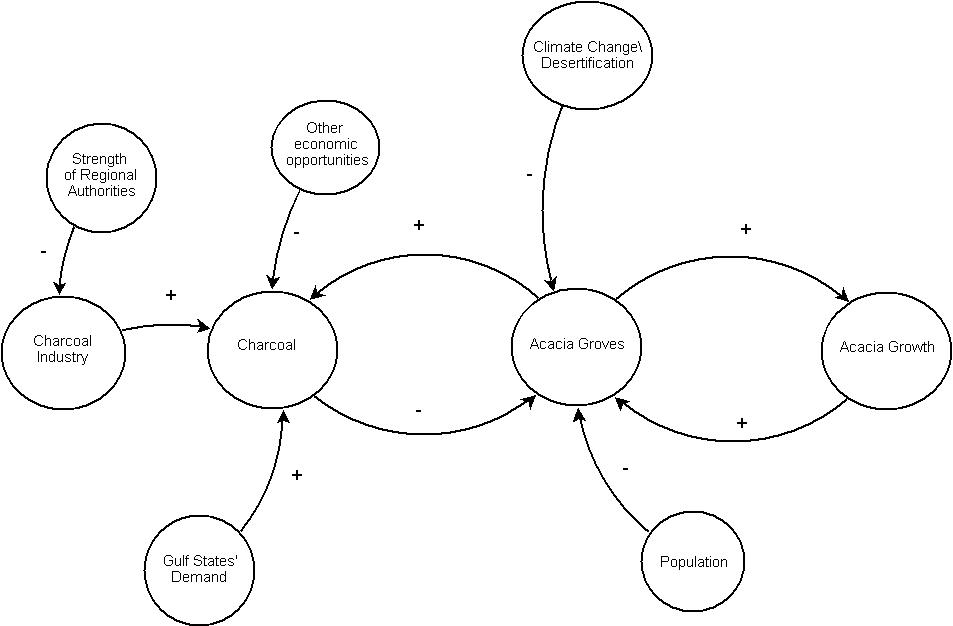The root cause of the destructive nature of the charcoal trade in Somalia is the lack of rule of law and an effective government with the power, authority, and will to restrict the activities of charcoal traders. This case study will first provide a brief historical overview of the political situation that has given rise to the environment in which traders can profit from the trade in charcoal. Next, this case study will explain the details of how the charcoal industry operates. Finally, the case study will follow the ICE template to describe the relationship between the charcoal industry, low-level conflict, and the environment.
In 1991, the two decades of military dictatorship of Siad Barre came to an unceremonious end. With his regime weakened with the end of the bi-polar era and unable to coerce or co-opt his political opponents, the United Somali Congress (USC) ousted Barre from Mogadishu. The USC, led by General Muhammad Farah Aideed, failed to establish a government of national unity and broke apart between rival faction leaders. The years from 1991-1994 were marked by extreme brutality and clan-based violence fueled by decades of clanism and cronyism under the Barre regime.
During the mid- to late-1990s, faction leaders gradually lost their power and appeal as regional administrations and other local forms of governance challenged their authority. One such arrangement was the system of Islamic courts that emerged, providing a significant degree of stability and rule of law. A coalition of Islamic courts and local authorities that recently rose to national prominence and power in late 2006 was the Union of Islamic Courts (UIC), until their ouster by Ethiopia in early 2007. In 2000, a peace conference held in Arta, Djibouti and heavily supported by the Arab league produced the Transitional National Government (TNG). This weak and ineffective administration was heavily opposed by many section of Somali society, and failed to establish a functioning government. Another attempt by TNG opponents to form a national government in 2002 resulted in the Transitional Federal Government (TFG), but this arrangement represented even more narrow interests, particularly those of Abdullahi Yusuf, then President of the semi-autonomous administration of Puntland. Failing to establish itself as a legitimate authority, the TFG nearly collapsed into irrelevance with the rise of the UIC in Mogadishu, but Ethiopian support and military intervention has since put the TFG in power in Mogadishu. Currently, the TFG has the support of the international community but is mistrusted by most of the Hawiye clan, the dominant clan in Mogadishu, and faces an insurgence lead by Hawiye clan members and remnants of the hard-line elements of the UIC.
Under the rule of General Muhammad Farah Aideed, who exerted control over much of Southern Somalia and Southern Mogadishu from 1992-1997, the charcoal trade was banned because of the serious toll it exacted on the environment. However, the ban on the charcoal trade died with General Aideed in 1996. General Aideed’s son, Hussein Muhammad Aideed, imposed no such restrictions on the trade, allowing traders to over-exploit southern Somalia’s savannahs and dense forests. Local authorities and clan elders attempted to restrict the trade themselves, but this led to violent clashes between clans. Since then, both the TNG and, more recently, the Union of Islamic Courts, have tried to stop the harmful trade, but have met with little success. With President Yusuf of the TFG at the helm of Somalia’s weak interim government, the charcoal industry is unlikely to be reined in, as President Yusuf used taxes on the charcoal industry to help fund his administration in Puntland. His connections with the businessmen and traders not only helped him profit from the charcoal trade, but also to import arms to support his militias despite the UN weapons embargo on Somalia.
The reason for these failures is that there is a strong economic incentive for traders to continue to export Somalia’s natural resources. High demand for charcoal in the Gulf States, due to their strict laws on preventing local deforestation, has created opportunities for large profits for traders willing to brave the ports of Kismayo and Mogadishu. At the year 2000, Somali charcoal traders would sell a bag of charcoal to a merchant in Kismayo for around US$3-4. That merchant would then sell that charcoal in one of the Gulf States for around US$10 And the Gulf States have been more than willing to engage in this trade, taking advantage of Somalia’s political situation to gain access to much needed energy sources at a relatively low cost. The high demand for charcoal in Gulf States also coincides with a dearth of other options for many Somalis. With a ban on cattle exports, and other methods of livelihood made unavailable because of the economic and political situation, the lure of an income from the charcoal trade becomes more understandable.
|
Production |
Transportation |
Shipment |
Sale |
Actors |
Local militias |
Middlemen
Militia roadblocks |
Merchant ship-owners |
Merchants in Gulf states |
Activities |
Cutting trees
Burning wood into charcoal |
Transporting over land to ports
Navigating roadblocks |
Loading and shipping |
Charcoal marketed for local use |
Costs |
Avg. Somali income in charcoal trade:
~$.80 a day |
Clan tax for land: ~$.20 a month
Local Authority Tax: ~$.10 per load
Transport: ~$3-4 per load
Road block fees: varies |
~$3-4 a bag |
~$10 a bag |
Charcoal is made by burning wood in an enclosed area at high temperatures. In Somalia, this is usually done in small space dug out of the earth and enclosed with concrete blocks and brush piled on to seal in the air, or, as is pictured, in a steel drum. This is either done by local Somalis who have no other economic options, or sometimes by local militias with chainsaws. They then sell the charcoal in bags usually weighing about 25kg each to militias to transport to a port by truck or donkey cart. During transportation, loads of charcoal must pay local authorities taxes, as well as roadblock fees, and sometimes taxes on using clan lands. When they reach the city, Somali businessmen connect local militias with merchants operating vessels willing to brave the shady legal environment of the charcoal trade. These merchants buy bags of charcoal for around $3-4 each, but once they reach Saudi Arabia or the UAE, they can sell for around $10 a bag. This huge amount of profit balances the risk of international waters and the expense of transport through Somalia’s often dangerous environs.
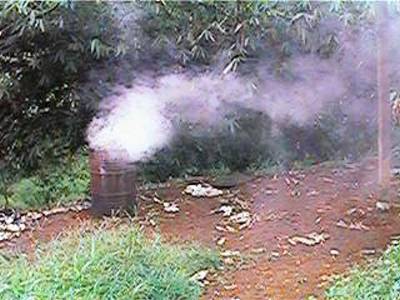
http://www.worldproutassembly.org/images/charcoal-2.jpg

http://www.worldproutassembly.org/images/charcoal-4.jpg
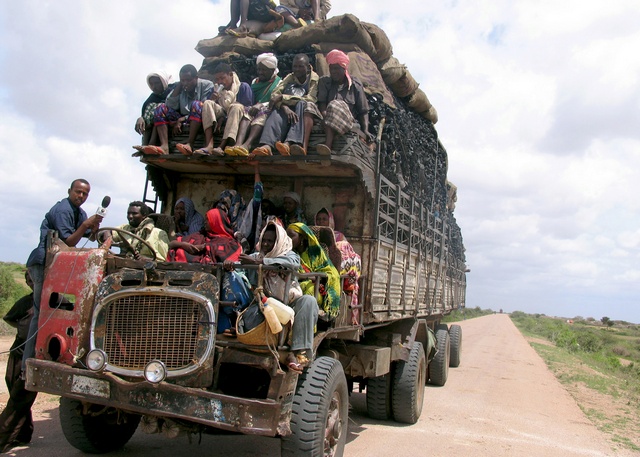
http://www.biyokulule.com/Charcoal%20truck1.jpg
The effect that this system of economic incentives is having is difficult to measure because of Somalia’s security situation. However, considering the charcoal industry has been behind deforestation in other parts of Africa, one can assume that, with the lack of any oversight or restrictions, the charcoal trade will have a devastating effect on Somalia’s forests. This is also likely to increase the occurrence of desertification in Somalia, depriving pastoralists of grazing land and farmers of cultivatable areas. Income from the charcoal trade also provides important financing for some warlords and faction leaders, enabling them to maintain their strength and continue their predatory regimes. While predatory militias profit from the charcoal industries, it is the more powerful businessmen that are the real power behind the industry. This section of society is powerful enough to hold a veto over any political arrangement that threatens their interests. Thus, any attempts to halt the charcoal industry must court the very businessmen that profit the most from it.
Unfortunately, as forests become sparser but demand in the Gulf States continues, or even rises with other fuel costs, intense competition may ensue over controlling the remnants of Somalia’s charcoal industry. There has already been conflict between clans over the charcoal trade, and this will only become more likely as competition intensifies. As deforestation and desertification limit the availability of other natural resources, conflict around these is likely to rise, as well. Somalis who rely on the acacia forests for their livelihood will see their opportunities for supplementing their income decrease, as game dies out, desertification hurts farming, and the eventual destruction of the acacia groves will also end their ability to supplement their income by participating in the charcoal trade. With charcoal supplies shrinking, the cost of fuel for domestic use will also continue to rise, raising the cost of living for Somali families. The situation in the Sudan is an analogous one, where scarce resources exacerbate and create ethnic and racially based narratives of grievances.




